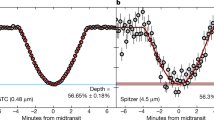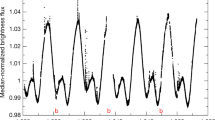Abstract
Most stars become white dwarfs after they have exhausted their nuclear fuel (the Sun will be one such). Between one-quarter and one-half of white dwarfs have elements heavier than helium in their atmospheres1,2, even though these elements ought to sink rapidly into the stellar interiors (unless they are occasionally replenished)3,4,5. The abundance ratios of heavy elements in the atmospheres of white dwarfs are similar to the ratios in rocky bodies in the Solar System6,7. This fact, together with the existence of warm, dusty debris disks8,9,10,11,12,13 surrounding about four per cent of white dwarfs14,15,16, suggests that rocky debris from the planetary systems of white-dwarf progenitors occasionally pollutes the atmospheres of the stars17. The total accreted mass of this debris is sometimes comparable to the mass of large asteroids in the Solar System1. However, rocky, disintegrating bodies around a white dwarf have not yet been observed. Here we report observations of a white dwarf—WD 1145+017—being transited by at least one, and probably several, disintegrating planetesimals, with periods ranging from 4.5 hours to 4.9 hours. The strongest transit signals occur every 4.5 hours and exhibit varying depths (blocking up to 40 per cent of the star’s brightness) and asymmetric profiles, indicative of a small object with a cometary tail of dusty effluent material. The star has a dusty debris disk, and the star’s spectrum shows prominent lines from heavy elements such as magnesium, aluminium, silicon, calcium, iron, and nickel. This system provides further evidence that the pollution of white dwarfs by heavy elements might originate from disrupted rocky bodies such as asteroids and minor planets.
This is a preview of subscription content, access via your institution
Access options
Subscribe to this journal
Receive 51 print issues and online access
$199.00 per year
only $3.90 per issue
Buy this article
- Purchase on Springer Link
- Instant access to full article PDF
Prices may be subject to local taxes which are calculated during checkout



Similar content being viewed by others
References
Zuckerman, B., Melis, C., Klein, B., Koester, D. & Jura, M. Ancient planetary systems are orbiting a large fraction of white dwarf stars. Astrophys. J. 722, 725–736 (2010)
Koester, D., Gänsicke, B. T. & Farihi, J. The frequency of planetary debris around young white dwarfs. Astron. Astrophys. 566, A34 (2014)
Paquette, C., Pelletier, C., Fontaine, G. & Michaud, G. Diffusion in white dwarfs—new results and comparative study. Astrophys. J. 61 (Suppl.), 197–217 (1986)
Aannestad, P. A., Kenyon, S. J., Hammond, G. L. & Sion, E. M. Cool metallic-line white dwarfs, radial velocities, and interstellar accretion. Astron. J. 105, 1033–1044 (1993)
Koester, D. Accretion and diffusion in white dwarfs. New diffusion timescales and applications to GD 362 and G 29–38. Astron. Astrophys. 498, 517–525 (2009)
Zuckerman, B., Koester, D., Melis, C., Hansen, B. M. & Jura, M. The chemical composition of an extrasolar minor planet. Astrophys. J. 671, 872–877 (2007)
Farihi, J., Gänsicke, B. T. & Koester, D. Evidence for water in the rocky debris of a disrupted extrasolar minor planet. Science 342, 218–220 (2013)
Zuckerman, B. & Becklin, E. E. Excess infrared radiation from a white dwarf—an orbiting brown dwarf? Nature 330, 138–140 (1987)
Jura, M. A tidally disrupted asteroid around the white dwarf G29–38. Astrophys. J. 584, L91–L94 (2003)
Becklin, E. E. et al. A dusty disk around GD 362, a white dwarf with a uniquely high photospheric metal abundance. Astrophys. J. 632, L119–L122 (2005)
Kilic, M., von Hippel, T., Leggett, S. K. & Winget, D. E. Excess infrared radiation from the massive DAZ white dwarf GD 362: a debris disk? Astrophys. J. 632, L115–L118 (2005)
Jura, M., Farihi, J., Zuckerman, B. & Becklin, E. E. Infrared emission from the dusty disk orbiting GD 362, an externally polluted white dwarf. Astron. J. 133, 1927–1933 (2007)
Kilic, M., von Hippel, T., Leggett, S. K. & Winget, D. E. Debris disks around white dwarfs: the DAZ connection. Astrophys. J. 646, 474–479 (2006)
Farihi, J., Jura, M. & Zuckerman, B. Infrared signatures of disrupted minor planets at white dwarfs. Astrophys. J. 694, 805–819 (2009)
Barber, S. D. et al. The frequency of debris disks at white dwarfs. Astrophys. J. 760, 26 (2012)
Rocchetto, M., Farihi, J., Gänsicke, B. T. & Bergfors, C. The frequency and infrared brightness of circumstellar discs at white dwarfs. Mon. Not. R. Astron. Soc. 449, 574–587 (2015)
Debes, J. H. & Sigurdsson, S. Are there unstable planetary systems around white dwarfs? Astrophys. J. 572, 556–565 (2002)
Vanderburg, A. & Johnson, J. A. A technique for extracting highly precise photometry for the two-wheeled Kepler mission. Publ. Astron. Soc. Pacif. 126, 948–958 (2014)
Kovács, G., Zucker, S. & Mazeh, T. A box-fitting algorithm in the search for periodic transits. Astron. Astrophys. 391, 369–377 (2002)
Rappaport, S. et al. Possible disintegrating short-period super-Mercury orbiting KIC 12557548. Astrophys. J. 752, 1 (2012)
Rappaport, S. et al. KOI-2700b—a planet candidate with dusty effluents on a 22 hr orbit. Astrophys. J. 784, 40 (2014)
Sanchis-Ojeda, R. et al. The K2-ESPRINT project I: discovery of the disintegrating rocky planet with a cometary head and tail EPIC 201637175b. Preprint at http://arxiv.org/abs/1504.04379 (2015)
Perez-Becker, D. & Chiang, E. Catastrophic evaporation of rocky planets. Mon. Not. R. Astron. Soc. 433, 2294–2309 (2013)
Rappaport, S., Sanchis-Ojeda, R., Rogers, L. A., Levine, A. & Winn, J. N. The Roche limit for close-orbiting planets: minimum density, composition constraints, and application to the 4.2 hr planet KOI 1843.03. Astrophys. J. 773, L15 (2013)
Davidsson, B. J. R. Tidal splitting and rotational breakup of solid spheres. Icarus 142, 525–535 (1999)
Farihi, J., Zuckerman, B. & Becklin, E. E. Spitzer IRAC observations of white dwarfs. I. Warm dust at metal-rich degenerates. Astrophys. J. 674, 431–446 (2008)
Veras, D., Leinhardt, Z. M., Bonsor, A. & Gänsicke, B. T. Formation of planetary debris discs around white dwarfs—I. Tidal disruption of an extremely eccentric asteroid. Mon. Not. R. Astron. Soc. 445, 2244–2255 (2014)
Veras, D., Eggl, S. & Gänsicke, B. T. Sublimation-induced orbital perturbations of extrasolar active asteroids and comets: application to white dwarf systems. Mon. Not. R. Astron. Soc. 452, 1945–1957 (2015)
Lin, H. W. & Loeb, A. Finding rocky asteroids around white dwarfs by their periodic thermal emission. Astrophys. J. 793, L43 (2014)
Croll, B. et al. Multiwavelength observations of the candidate disintegrating sub-Mercury KIC 12557548b. Astrophys. J. 786, 100 (2014)
Acknowledgements
We thank B. Croll, D. Veras, M. Holman, R. Loomis, J. Becker, K. Deck, H. Schlichting, H. Lin, A. Loeb, and D. Osip for discussions and assistance. We thank C. Allinson, S. Dillet, D. Frostig, A. Johnson, D. Hellstrom, S. Johnson, B. Peak, and T. Reneau for conducting MINERVA observations. We thank M. Wyatt for suggesting how to present Supplementary Fig. 8. A.V. is supported by a National Science Foundation Graduate Research Fellowship (grant DGE 1144152). J.A.J. is supported by grants from the David and Lucile Packard Foundation and the Alfred P. Sloan Foundation. The Center for Exoplanets and Habitable Worlds is supported by Pennsylvania State University, the Eberly College of Science, and the Pennsylvania Space Grant Consortium. The MEarth Team acknowledges funding from the David and Lucile Packard Fellowship for Science and Engineering (to D.C.), the National Science Foundation under grants AST-0807690, AST-1109468, and AST-1004488 (Alan T. Waterman Award), and a grant from the John Templeton Foundation. The opinions expressed here are those of the authors and do not necessarily reflect the views of the John Templeton Foundation. This research has made use of NASA’s Astrophysics Data System, the SIMBAD database and VizieR catalog access tool operated at the Centre de Données astronomiques de Strasbourg, France. Some of the data presented here were obtained from the Mikulski Archive for Space Telescopes (MAST). This paper includes data from the Kepler/K2 mission, the Wide-field Infrared Survey Explorer, the MMT Observatory, the Sloan Digital Sky Survey (SDSS-III), the National Geographic Society—Palomar Observatory Sky Atlas (POSS-I) and the W.M. Keck Observatory. MINERVA is made possible by contributions from its collaborating institutions and Mt Cuba Astronomical Foundation, the David and Lucile Packard Foundation, the National Aeronautics and Space Administration, and the Australian Research Council. We acknowledge the cultural significance of the summit of Maunakea within the indigenous Hawai’ian community. We are grateful for the opportunity to conduct observations from this mountain.
Author information
Authors and Affiliations
Contributions
A.V. processed and searched the K2 data, identified this system, analysed the K2 data for WD 1145+017 (with help from S.R., D.K., and J.T.W.), processed the MINERVA data, measured radial velocities (with help from W.R.B. and D.W.L.), and was the primary author of the manuscript. S.R. performed the dynamical calculations and dust simulations. W.R.B. obtained and reduced the MMT spectra. P.D. analysed the MMT spectra and SDSS photometry to measure spectroscopic properties. J.A.L. analysed archival photometric measurements and modelled the excess infrared emission. A.B. and D.W.L. obtained and processed the FLWO data. J.I. and D.C. obtained and processed the MEarth data. D.R.C. and C.B. obtained and processed the Keck data. R.A. calculated the systematics insensitive periodogram. L.S. calculated vapour pressures for some minerals with MAGMA. J.A.J., J.E., N.M., R.A.W., and J.T.W. made it possible to use MINERVA. J.A.J. provided scientific leadership.
Corresponding author
Ethics declarations
Competing interests
The authors declare no competing financial interests.
Additional information
The raw K2 data are available at http://archive.stsci.edu/k2/data_search/search.php under the identification number 201563164. The processed K2 data are available at https://archive.stsci.edu/missions/hlsp/k2sff/html/c01/ep201563164.html. We have opted not to make the code used in this work available.
Supplementary information
Supplementary Information
This file contains Supplementary Text and Data, Supplementary References, Supplementary Tables 1-2 and Supplementary Figures 1-9. (PDF 1706 kb)
Supplementary Data
This file contains source data for Supplementary Figure 1. The ground based light curves we obtained. The columns alternate between timestamps and flux measurements, and the column headers describe the facility and wavelength of observations. (TXT 190 kb)
Supplementary Data
This file contains Source Data for Figure 2. The K2 light curve (flux measurements, timestamps, fit to low frequency variations (which we divide out to produce the light curve shown and analysed in the manuscript), and timestamps folded on the period and phase of the dominant 4.5 hour signal. (TXT 157 kb)
Supplementary Data
This file contains Source Data for Supplementary Figure 3. The five individual spectra we obtained. The columns alternate between wavelength and flux. The column headers give the time of each observation. (TXT 288 kb)
Rights and permissions
About this article
Cite this article
Vanderburg, A., Johnson, J., Rappaport, S. et al. A disintegrating minor planet transiting a white dwarf. Nature 526, 546–549 (2015). https://doi.org/10.1038/nature15527
Received:
Accepted:
Published:
Issue Date:
DOI: https://doi.org/10.1038/nature15527
This article is cited by
-
The search for living worlds and the connection to our cosmic origins
Experimental Astronomy (2022)
-
Gaseous atomic nickel in the coma of interstellar comet 2I/Borisov
Nature (2021)
-
Shapes, structures, and evolution of small bodies
Astrodynamics (2021)
-
Spitzer’s debris disk legacy from main-sequence stars to white dwarfs
Nature Astronomy (2020)
-
Creating the first interstellar interloper
Nature Astronomy (2020)
Comments
By submitting a comment you agree to abide by our Terms and Community Guidelines. If you find something abusive or that does not comply with our terms or guidelines please flag it as inappropriate.



